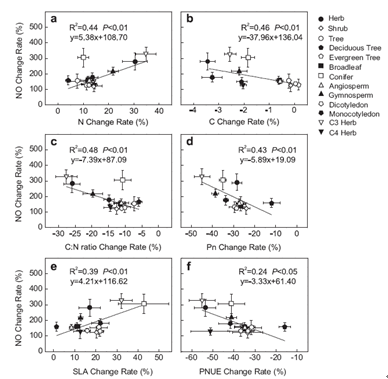Chen J, FH Wu, TW Liu, L Chen, Q Xiao, XJ Dong, JX He, ZM Pei and HL Zheng.Environmental Pollution, 2012. 160: 192-200.
To assess the potential contribution of nitric oxide (NO) emission from the plants grown under the increasing nitrogen (N) deposition to atmospheric NO budget, the effects of simulated N deposition on NO emission and various leaf traits (e.g., specific leaf area, leaf N concentration, net photosynthetic rate, etc.) were investigated in 79 plant species classified by 13 plant functional groups. Simulated N deposition induced the significant increase of NO emission from most functional groups, especially from conifer, gymnosperm and C3 herb. Moreover, the change rate of NO emission was significantly correlated with the change rate of various leaf traits. We conclude that the plants grown under atmospheric N deposition, especially in conifer, gymnosperm and C3 herb, should be taken into account as an important biological source of NO and potentially contribute to atmospheric NO budget.

Fig. 4 Relationship between the change rate of NO emission rate and leaf N concentration (a), leaf C concentration (b), C:N ratio (c), net photosynthetic rate (Pn) (d), specific leaf area (SLA) (e) and photosynthetic N use efficiency (PNUE) (f) across different plant functional groups exposed to simulated N deposition. The change rate was calculated by a ratio of the increase/decrease value of NO emission rate, leaf N, C, C:N ratio, Pn, SLA and PNUE induced by simulated N deposition to those of normal condition. Different functional groups are indicated with different symbols. Each point represents the mean value of different species in a plant functional group and bars represent the standard error (SE) of the mean. The linear regressions analysis was conducted by the Pearson correlation of SPSS 13.0 statistical package.

